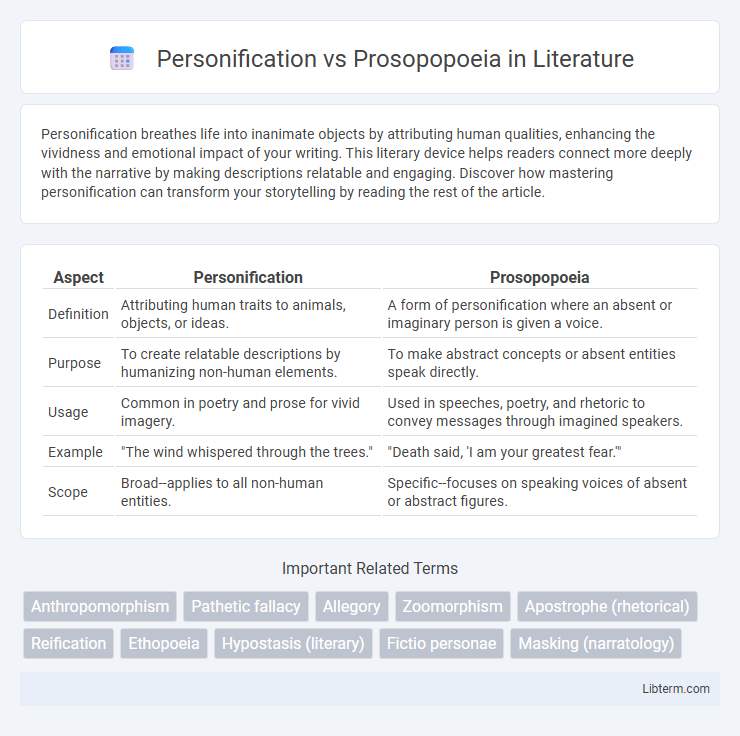Personification breathes life into inanimate objects by attributing human qualities, enhancing the vividness and emotional impact of your writing. This literary device helps readers connect more deeply with the narrative by making descriptions relatable and engaging. Discover how mastering personification can transform your storytelling by reading the rest of the article.
Table of Comparison
| Aspect | Personification | Prosopopoeia |
|---|---|---|
| Definition | Attributing human traits to animals, objects, or ideas. | A form of personification where an absent or imaginary person is given a voice. |
| Purpose | To create relatable descriptions by humanizing non-human elements. | To make abstract concepts or absent entities speak directly. |
| Usage | Common in poetry and prose for vivid imagery. | Used in speeches, poetry, and rhetoric to convey messages through imagined speakers. |
| Example | "The wind whispered through the trees." | "Death said, 'I am your greatest fear.'" |
| Scope | Broad--applies to all non-human entities. | Specific--focuses on speaking voices of absent or abstract figures. |
Understanding Personification: Definition and Origins
Personification is a literary device that attributes human characteristics to non-human entities, such as animals, objects, or ideas, enhancing vivid imagery and emotional connection. Originating from classical rhetoric, personification has roots in ancient Greek and Latin literature, where it was used to animate abstract concepts like Justice or Death. This technique is fundamental in poetry and storytelling, allowing writers to create relatable and memorable narratives by imbuing lifeless elements with human qualities.
Prosopopoeia Explained: Meaning and Historical Roots
Prosopopoeia is a rhetorical device where an abstract idea, inanimate object, or absent person is given human characteristics and is made to speak or act, enhancing emotional connection in literature and speeches. Historically, prosopopoeia dates back to classical antiquity, prominently used by orators like Cicero to personify virtues, vices, or nations, creating vivid and persuasive imagery. This technique differs from simple personification by involving direct speech or action from the personified entity, making it a dynamic form of characterization.
Key Differences Between Personification and Prosopopoeia
Personification attributes human traits to non-human objects or abstract ideas, enhancing imagery by making descriptions more relatable. Prosopopoeia, a specific form of personification, involves giving voice or speech to an inanimate object or absent person, often used in rhetoric to convey arguments or emotions directly. The key difference lies in personification's broader application of human qualities, whereas prosopopoeia uniquely entails direct speech or representation of a persona.
Personification in Literature: Classic Examples
Personification in literature attributes human traits to non-human entities, enriching narratives with vivid imagery and emotional depth. Classic examples include Shakespeare's depiction of Death in "Romeo and Juliet" as a cruel, unseen force and Emily Dickinson's poem "Because I could not stop for Death," where Death is personified as a polite gentleman. This literary device animates abstract concepts, making complex ideas more relatable and engaging for readers.
Prosopopoeia in Rhetoric: Powerful Instances
Prosopopoeia in rhetoric involves giving voice to inanimate objects, abstract ideas, or absent entities, creating vivid and persuasive communication. This technique enhances emotional appeal and engagement by allowing speakers to dramatize perspectives, often seen in political speeches where nations or ideals "speak" directly to the audience. Unlike general personification, prosopopoeia specifically assigns speech or articulation, making abstract concepts tangible and memorable for listeners.
Semantic Nuances: When to Use Personification vs Prosopopoeia
Personification attributes human qualities to inanimate objects or abstract concepts, enhancing imagery and emotional connection in literature by making ideas relatable, whereas prosopopoeia involves giving a voice to an absent or imaginary person or object, often used to express speeches or thoughts that convey a deeper narrative or moral message. Use personification to create vivid, emotive descriptions that animate non-human elements, while prosopopoeia is effective for dramatizing perspectives or highlighting philosophical arguments through a fictitious or historical character's speech. Understanding the semantic nuance helps writers decide between evoking empathy through human traits or presenting argumentative dialogue via personified voices within a text.
Literary Impact: Effects on Reader Interpretation
Personification imbues abstract concepts or inanimate objects with human traits, enhancing emotional connection and vivid imagery in literature. Prosopopoeia, a form of personification where absent or non-human entities speak, creates a powerful narrative voice that can challenge reader perception and deepen thematic engagement. Both techniques shape interpretation by animating the non-human, but prosopopoeia uniquely amplifies authority and immediacy through direct speech.
Role in Poetry and Prose: Comparative Application
Personification imbues inanimate objects or abstract concepts with human-like qualities, enhancing imagery and emotional resonance in both poetry and prose. Prosopopoeia extends personification by granting speech, allowing non-human entities or absent persons to articulate thoughts, thus deepening narrative engagement. In poetry, personification often creates vivid metaphors, while prosopopoeia in prose serves as a powerful rhetorical device to animate arguments or evoke empathy.
Common Misconceptions and Overlaps
Personification and prosopopoeia both involve attributing human characteristics to non-human entities, but prosopopoeia specifically entails giving voice to these entities, allowing them to speak or express thoughts directly. A common misconception is that personification always includes speech, whereas it primarily uses human traits for descriptive purposes without necessarily granting a 'voice.' The overlap between the two lies in their shared use of human qualities, but prosopopoeia is a more specialized rhetorical device emphasizing direct embodied speech.
Summary: Choosing the Right Device for Effective Expression
Personification attributes human qualities to inanimate objects or abstract concepts, enhancing imagery and emotional connection in writing. Prosopopoeia, a specific form of personification, involves speaking or narrating as a personified object or idea, often used for dramatic effect or persuasive speech. Selecting between these devices depends on the desired impact: use personification to create vivid descriptions and prosopopoeia for active, voice-driven expression.
Personification Infographic

 libterm.com
libterm.com